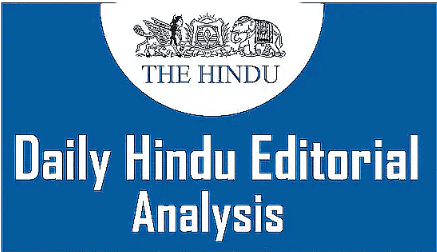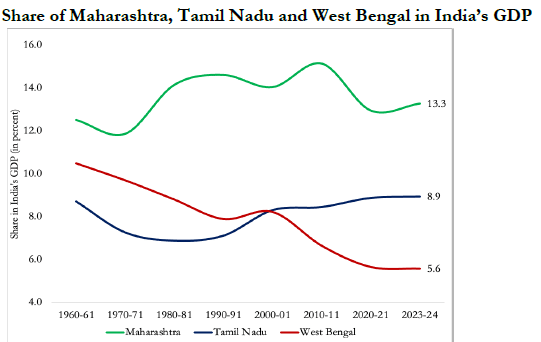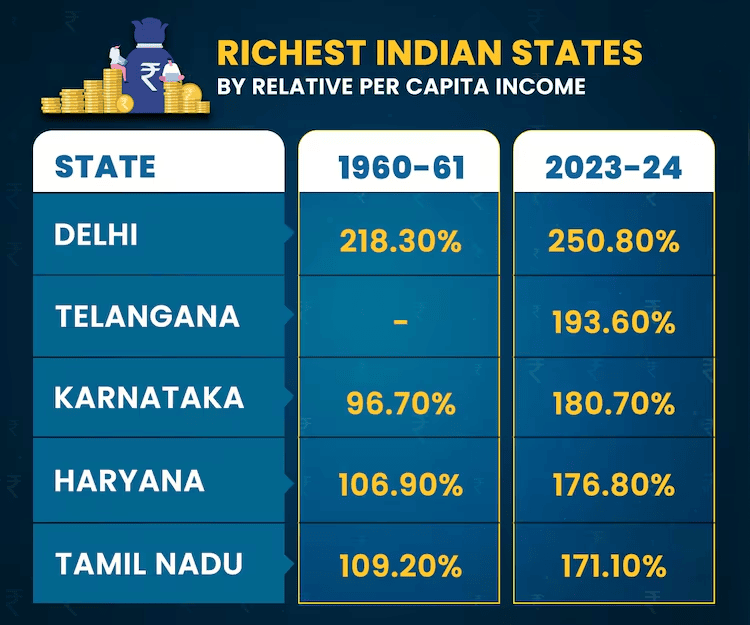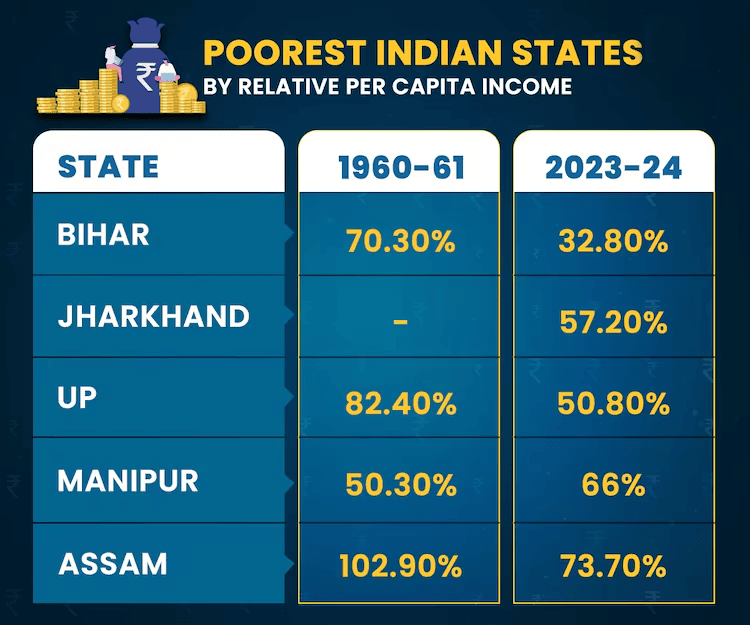UPSC Exam > UPSC Notes > Current Affairs & Hindu Analysis: Daily, Weekly & Monthly > The Hindu Editorial Analysis- 30th October 2024
The Hindu Editorial Analysis- 30th October 2024 | Current Affairs & Hindu Analysis: Daily, Weekly & Monthly - UPSC PDF Download

A picture of a growing economic divide in India
Why in News?
The Economic Advisory Council to the Prime Minister (EAC-PM) recently released a report titled ‘Relative Economic Performance of Indian States: 1960-61 to 2023-24’.
- The report highlighted a significant disparity in the economic performance of Indian states from 1960-61 to 2023-24.
What are the Key Findings of the EAC-PM Report?
- Economic Performance:
- Southern States' Growth:
- The southern states of India, including Karnataka, Andhra Pradesh, Telangana, Kerala, and Tamil Nadu, have become important players in the country's economy.
- By March 2024, these states contributed 30% to India's total GDP.
- Their economic growth picked up speed after the country opened up its markets, leading to big improvements in areas like technology and industry.
- West Bengal's Economic Decline:
- West Bengal's share of GDP has fallen from 10.5% in 1960-61 to just 5.6% in 2024.
- The state's per capita income has dropped from 127.5% of the national average in the 1960s to 83.7% in 2024, making it fall behind states like Rajasthan and Odisha.
- Several factors have contributed to this decline, including:
- Stagnation in government policies
- A decrease in industrial activities
- Political instability
- Migration of skilled workers
- These issues have slowed down growth and made the state less attractive for investments.

- Maharashtra is the biggest contributor to India's GDP, making up 13.3%.
- However, its contribution has decreased from over 15%.

Per Capita Income Data:
- Delhi, Telangana, Karnataka, and Haryana had the highest per capita income relative to the national average in 2023-24.
- Delhi's per capita income is 250.8% of the national average.
- Gujarat has a per capita income of 160.7% of the national average, while Maharashtra stands at 150.7%. Both states have maintained incomes above the national average since the 1960s.
- Odisha has seen a significant rise in per capita income, increasing from 55.8% in 2000-01 to 88.5% in 2023-24.
- When comparing Punjab and Haryana:
- Punjab has faced economic stagnation since 1991, with its per capita income dropping to 106% of the national average.
- In contrast, Haryana has seen strong growth, with its per capita income increasing to 176.8%.
- Among smaller states:
- Sikkim’s per capita income grew from 93% of the national average in 1990-91 to 319% in 2023-24.
- Goa also improved its income from 144% in 1970-71 to 290%.
- Both Sikkim and Goa are now among the richest states in India based on per capita income.

- States like Uttar Pradesh and Bihar face major challenges in their economic growth.
- Uttar Pradesh contributes only 9.5% to the country's GDP.
- Bihar contributes even less, at just 4.3%.
- Although some states, such as Odisha, have shown improvements, Bihar is still lagging far behind in terms of economic development.

- The report emphasizes the importance of a thorough examination of the policies and factors that affect economic growth at the state level.
- It particularly aims to tackle the growing regional inequalities in India.
- There is a need to understand better how different policies impact economic performance.
- This investigation is crucial to finding solutions for the disparities seen between various regions.
What are the Reasons for Steady Growth in West and South States?
- Robust Industrial Base:Gujarat and Maharashtra have a solid and varied manufacturing sector, including areas like textiles, chemicals, and engineering.
- Their policies encourage investment, making it easier for businesses to thrive.
- This has attracted a lot of both local and international investments.
- Thriving Service Sector:States in the south, like Karnataka and Tamil Nadu, have seen quick growth in cities and better infrastructure.
- This growth has positively impacted their IT and service industries.
- There is a strong emphasis on education and skill development, leading to a talented workforce.
- This skilled workforce boosts productivity and economic development.
- Agricultural Advancements:Maharashtra and Kerala are using sustainable farming methods.
- These include organic farming, growing different crops, and using water-saving irrigation techniques.
- They also practice agroforestry and offer a variety of products, which increases productivity and food security.
- Government support for irrigation, market access, and technology has improved farming results and economic progress.
- Strong Regional Connectivity:The western and southern regions have well-developed transport and logistics systems.
- Gujarat's ports and Tamil Nadu's roads facilitate trade effectively.
- The closeness to major markets increases local demand, driving economic growth in these areas.
Economic Advisory Council to the Prime Minister (EAC-PM)
- Independent Body: This organization is not part of the constitution or any law and operates independently.
- Purpose: Its main role is to provide advice on economic and related matters to the Government of India, especially to the Prime Minister.
- Neutral Perspective: The council focuses on bringing important economic issues to the government's attention from a neutral standpoint.
- Areas of Advice: It offers guidance to the Prime Minister on various economic topics such as inflation, microfinance, and industrial output.
- Nodal Agency:NITI Aayog acts as the main agency for the EAC-PM in areas like administration, logistics, planning, and budgeting.
- Reports: The council produces periodic reports, including the Annual Economic Outlook and the Review of the Economy.
What Measures Can be Taken to Enhance the Economic Performance of the States?
- Decentralised Planning and Governance: Empower local governments to create and implement development plans that meet local needs. Involve community members in decision-making to ensure everyone is included.
- Infrastructure Development: Focus on investing in roads, railways, ports, and digital connections through Public-Private Partnerships (PPP). This will improve trade and mobility while ensuring projects are completed on time and resources are used effectively.
- Sectoral Focus and Diversification: Increase agricultural productivity by using new technologies and better irrigation methods, while also supporting industries related to agriculture.
- Promote targeted policies that enhance manufacturing (like textiles and electronics) and services (such as IT and tourism) based on the strengths of each region.
- Skill Development and Human Capital: Create vocational training programs that align with what industries need, improving job opportunities. Also, work on enhancing education quality by focusing on critical thinking skills and access to higher education.
- Innovation and Entrepreneurship: Encourage a culture of innovation by supporting startups through incubators and funding. Promote partnerships among universities, businesses, and government for research that leads to new technologies.
- Digital Transformation: Use digital tools for governance to make public services more transparent and efficient. Also, support digital literacy programs to help citizens gain the skills they need.
- Collaborative Governance: Promote cooperation between states to share effective practices and resources. Ensure that central and state governments work together to align their policies and resources for development.
Conclusion
- The growth in the Western and Southern states is due to careful planning.
- These regions have strong industrial and service sectors.
- There are effective government policies in place that support this growth.
- There is a focus on sustainable practices to ensure long-term benefits.
- As these states continue to innovate and adjust to new economic situations, they are crucial in helping India aim for a USD 7 trillion economy by the year 2030.
- It is important to address regional differences and promote inclusive growth to keep this progress going.
- Ensuring balanced development across the entire country is key to sustaining this momentum.
The document The Hindu Editorial Analysis- 30th October 2024 | Current Affairs & Hindu Analysis: Daily, Weekly & Monthly - UPSC is a part of the UPSC Course Current Affairs & Hindu Analysis: Daily, Weekly & Monthly.
All you need of UPSC at this link: UPSC
|
38 videos|5269 docs|1114 tests
|
FAQs on The Hindu Editorial Analysis- 30th October 2024 - Current Affairs & Hindu Analysis: Daily, Weekly & Monthly - UPSC
| 1. What are the main factors contributing to the growing economic divide in India? |  |
Ans. The growing economic divide in India can be attributed to several factors including unequal access to education and healthcare, disparities in job opportunities, regional imbalances in development, and the impact of globalization which often benefits urban areas more than rural ones. Additionally, the COVID-19 pandemic has exacerbated existing inequalities, leading to job losses and economic hardship for lower-income groups.
| 2. How does the economic divide in India affect social stability? |  |
Ans. The economic divide in India can lead to social unrest and increased tension between different socio-economic groups. As disparities widen, disadvantaged communities may feel marginalized and excluded from the benefits of economic growth, potentially leading to protests, crime, and a general decline in social cohesion. It can also exacerbate existing caste and communal tensions.
| 3. What measures can be taken to reduce the economic divide in India? |  |
Ans. To reduce the economic divide in India, the government can implement policies focused on inclusive growth, such as improving access to quality education and healthcare, enhancing social safety nets, promoting skill development programs, and encouraging investment in underdeveloped regions. Additionally, fostering entrepreneurship and supporting small and medium enterprises can create more equitable job opportunities.
| 4. How has the COVID-19 pandemic influenced the economic divide in India? |  |
Ans. The COVID-19 pandemic has significantly influenced the economic divide in India by disproportionately impacting low-income workers and informal sector jobs. Many people lost their livelihoods, while wealthier individuals and sectors recovered more quickly. This has widened the gap between the rich and the poor, with many families falling deeper into poverty and lacking access to essential services.
| 5. Are there any positive trends regarding economic equality in India? |  |
Ans. Yes, there are some positive trends regarding economic equality in India, such as the growth of the middle class and increased awareness of economic issues. Government initiatives aimed at financial inclusion, such as the Pradhan Mantri Jan Dhan Yojana, have improved access to banking for marginalized communities. Additionally, social enterprises and NGOs are working to bridge the gap through innovative solutions and community-focused programs.
Related Searches





















